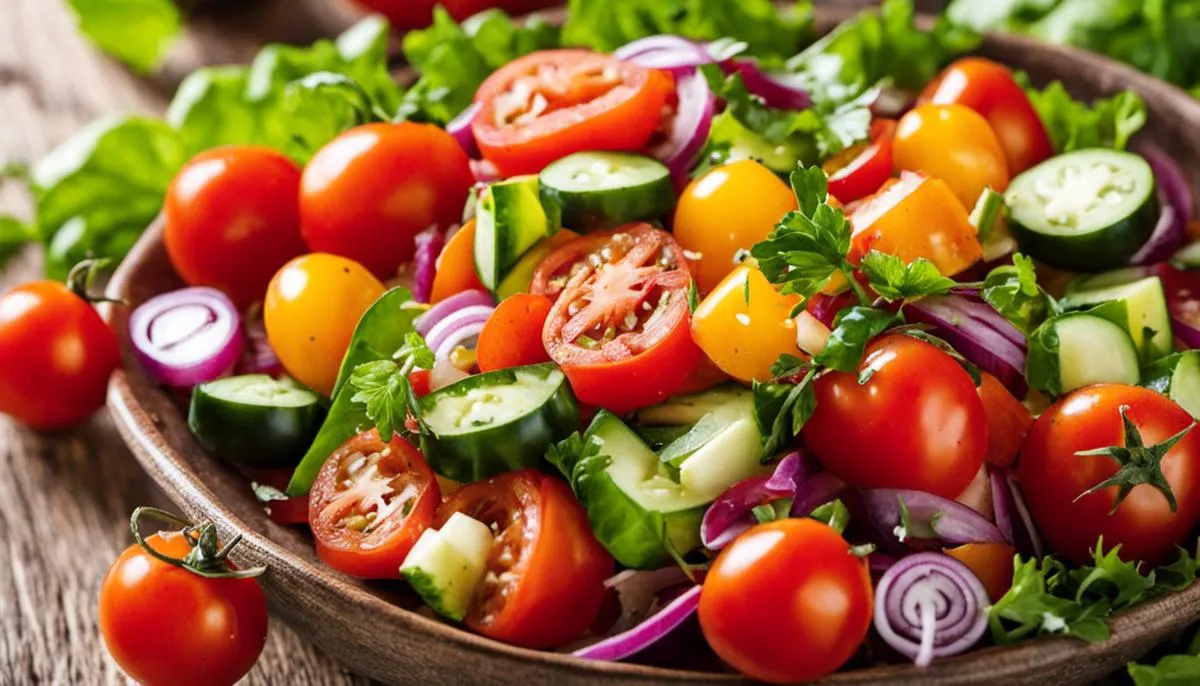Table of Contents
Unquestionably, tomatoes, the vibrant, juicy orbs of life, are not only a staple in many diets worldwide, but are also packed with an amazing array of nutrients. Often the unsung heroes in our kitchen, they are a rich source of vitamins, minerals, and potent antioxidants, cloaked within their distinctively aromatic, blushing red cover. But the story of tomatoes does not end simply at the nutritional benefits. These everyday fruits can be harnessed for their numerous health benefits, from augmenting heart health to improving skin condition. The best part is that you can easily integrate this nutritional powerhouse into your usual meals in a variety of delicious ways. However, like any other fresh produce, handling tomatoes calls for certain food safety practices to ensure they remain fresh and safe for consumption. So, dive into the world of tomatoes and discover how selecting, storing, and incorporating them into your diet can make a positive impact on your overall health.
Nutritional content of tomatoes
Tomatoes: A Health Powerhouse
Tomatoes are a substantial source of many powerful antioxidants, including lycopene, that are proven fundamentally beneficial to our health. Lycopene, the primary antioxidant in tomatoes, has been linked to many health benefits, including reduced risk of heart disease and cancer. Though it is often associated with the distinct red color, it’s interesting to know that lycopene is found in higher amounts when tomatoes are cooked rather than consumed raw. This nutrient also promotes skin health and may slow down the cellular damage caused by free radicals.
Vitamins and Minerals in Tomatoes
Despite being low in calories, tomatoes are packed with several vitamins and minerals. They are an excellent source of vitamin C, providing 21% of the daily recommended intake. Vitamin C is a key antioxidant which promotes wound healing, boosts immunity, and aids in the absorption of iron. Additionally, tomatoes contain potassium, a mineral that is often lacking in the modern diet. Potassium is pivotal as it aids nerve signaling, muscle contractions, and helps maintain a healthy blood pressure. Tomatoes also provide vitamin K, which is important for blood clotting and bone health, and folate, which is crucial for normal tissue growth and cell function.
Nutritional Importance of Tomato Fiber
Tomatoes are lauded for their rich nutritional profile, and one of the significant attributes includes their dietary fiber content. Eating one medium-sized tomato enables you to ingest roughly 1.5 grams of fiber. Fulfilling an essential role in your health, dietary fiber bolsters gut health and facilitates regular bowel movements. Additionally, it’s instrumental in lowering cholesterol levels, regulating blood sugar, and sustaining a healthy weight range. Consequently, the inclusion of tomatoes in your regular diet won’t just diversify your meals but also augment your overall health and wellbeing.

Health benefits of tomatoes
Key Nutritional Elements in Tomatoes
Tomatoes bring a wealth of essential nutrients to the table to foster and magnify our health. These fruits are densely packed with vitamins A, C, K, B6, folate, and thiamin. Vitamin A has the potential to enhance vision and stave off night blindness, whereas folate is noted for its efficacy in addressing fertility issues and mitigating stroke risk. In the meantime, the potassium content in tomatoes plays a crucial role in maintaining nerve function, and vitamin K aids in improving the body’s clotting capacity.
Besides these indispensable vitamins, tomatoes stand out for their impressive antioxidant concentration, with a special emphasis on lycopene. Lycopene is a carotenoid that imbues tomatoes with their red hue and is associated with a decreased risk of heart ailments and various forms of cancer, especially prostate cancer. As a potent antioxidant, lycopene neutralizes harmful free radicals in the body, shielding tissues and cells from damage. Moreover, the high fiber content in tomatoes boosts digestive health and might contribute to reducing heart disease risk. Tomatoes also offer a natural compound, choline, which aids in regulating sleep, muscle movement, learning processes, and memory function.
Promoting Heart and Skin Health Through Tomatoes
Tomatoes are not only delicious but also incredibly beneficial for overall health, particularly in promoting heart health and enhancing skin condition. The combination of potassium and vitamin B6 in these fruits actively work to decrease cholesterol and lower blood pressure, which together serve to reduce the likelihood of cardiovascular diseases. Additionally, the presence of folate in tomatoes aids in maintaining a balance in homocysteine levels, which can be harmful byproducts of protein metabolism that may potentially lead to the deterioration of blood vessels and cause heart-related ailments. As for improving skin health, the beneficial vitamin C found in tomatoes promotes the production of collagen, making these versatile fruits an excellent enhancement to beauty routines. Furthermore, the high concentration of lycopene and beta-carotene in tomatoes effectively shields the skin from damaging UV light, further improving skin health.

How to include tomatoes in diet
Effortless Ways to Add Tomatoes to Your Diet
Incorporating tomatoes into daily meals is a cinch and one of the best ways is to toss them into various salad dishes. A handful of tomatoes can instantly perk up the flavors of any salad, whether it’s a simple leafy green concoction, an enticing pasta mix, or a classic Greek salad. Besides the tantalizing burst of flavor it provides, tomatoes also bring a significant boost in vitamins A and C, and fiber content to the plate.
If you’re looking for a different way to enjoy tomatoes, try grilling them – a perfect addition to your barbecue spread. Simply cut the tomatoes in half, drizzle some olive oil, sprinkle a little bit of salt and pepper, and let them sizzle on the grill. Grilling heightens the tomatoes’ inherent sweetness while adding a distinct smoky flavor, making it a delightful culinary experience.
The Role of Tomatoes in Delicious Main Courses
One cannot underestimate the value tomatoes add to main dishes. Their inclusion in stews and soups lends an element of rich depth and robustness. Not to mention, the flavor profiles of numerous sauce-centric dishes, such as pasta, rely heavily on their influence.
Consider making a nutritious, tomato-based pasta sauce. The ingredient list is simple: ripe tomatoes, garlic, olive oil, and your choice of seasonings. Roasting the tomatoes intensifies their taste; blending them with sautéed garlic and oil culminates in a delightful sauce.
Suppose spices pique your interest? Fresh tomatoes are the key to a lively homemade salsa, which can jazz up any dish. Incorporating tomatoes in breakfast dishes, like omelettes and scrambles, introduces a tangy freshness. The same goes for sandwiches and burgers—just a slice or two can significantly enhance the texture, resulting in a moist, flavor-filled bite.

Before Cooking: Picking the Best Fresh Tomatoes
Like any culinary endeavor, using tomatoes starts with selecting the highest quality from your local grocery store or farmer’s market. It’s crucial to carefully inspect the tomatoes you’re purchasing.
Aim to select tomatoes with brilliant skin color, generally a dazzling red but you can also find exquisite yellow and green varieties. Additionally, they should have a firm texture that slightly yields under gentle pressure. Not to be overlooked is the scent—a good tomato should radiate a fresh, tantalizing aroma.
While inspecting, be sure to pass on tomatoes showing signs of spoilage: discoloration, mold, cuts, or other skin damage. These imperfections can harbor bacteria, presenting a risk of foodborne illness. When it comes to tomatoes, it’s always safety first.
Safe Storage Practices and Risks of Spoiled Tomatoes
Once you’ve selected your tomatoes, correct storage is vital for maintaining their nutritional value and safety. Store ripe tomatoes at room temperature away from direct sunlight and consume within a few days for the best flavor and freshness. Avoid refrigerating tomatoes, as this can affect their texture and taste. Should the tomatoes not be consumed quickly and begin to over-ripen, then refrigeration can be used as a last resort to extend their life by a few more days.
It’s essential to inspect tomatoes before eating. Consuming spoiled tomatoes, either through improper storage or past their freshness, can lead to foodborne illnesses. Over-ripe tomatoes can grow harmful bacteria and molds, visible as moldy spots or a foul smell, that can cause symptoms like stomach upset, vomiting, diarrhea, and in severe cases, even food poisoning. Therefore, whenever in doubt about the freshness of a tomato, it is better to discard it than risk your health. Combining these safety practices with a balanced diet, tomatoes can be an excellent source of vitamins A and C, potassium, and the antioxidant lycopene.

From the cradle of your kitchen, tomatoes definitely live up to their reputation as one of the best superfoods to be included in your daily diet. Full to the brim with powerful nutrients and health benefits, they promise a better state of health when consumed regularly and properly. With a variety of delectable ways to include tomatoes into your meals, you cannot go wrong with this excellent source of nourishment. Furthermore, respecting basic food safety principles will ensure the freshness and safety of your tomatoes, putting any potential health concerns at bay. Embrace tomatoes, their luscious taste, and their bountiful nutrients and benefits in your culinary routine for a happier, healthier life.

